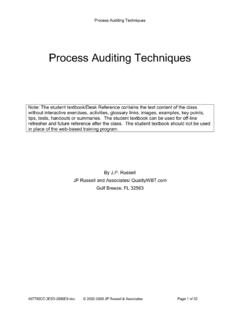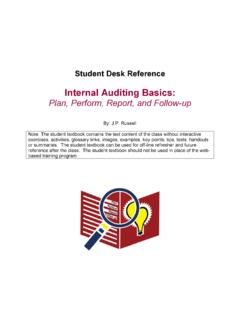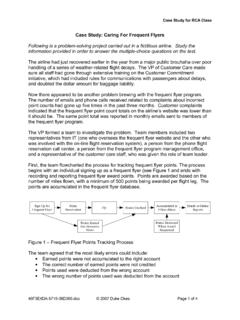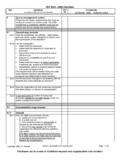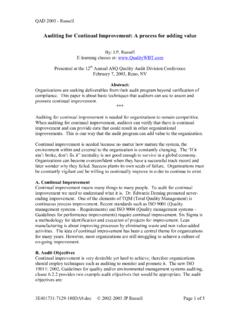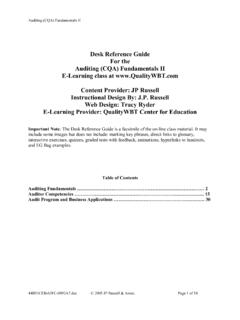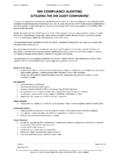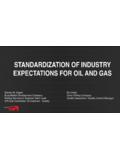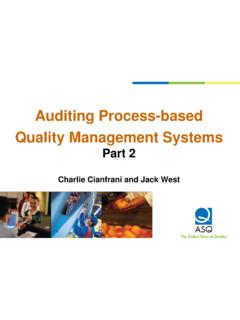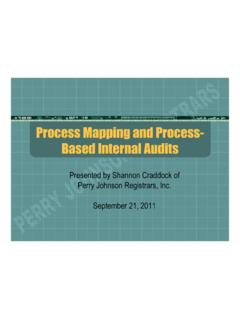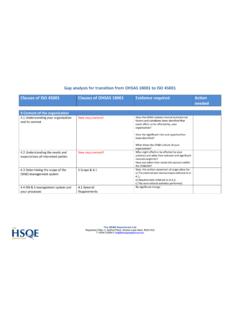Transcription of Continual Improvement Auditing - QualityWBT Center for ...
1 Continual Improvement Auditing The difference between Continual and continuous Improvement has been the subject of debate. The ISO 9001:2000 requires Continual Improvement but Total Quality Management, Six Sigma require continuous Improvement . In the late 90s, the pros and cons of using continuous or Continual Improvement in the proposed ISO 9001:2000 were discussed (debated). In a US Technical Advisory Group (TAG) to the American National Standards Institute for ISO/TC176 meeting (ISO 9000 quality management system oversight group): It was agreed to use Continual instead of continuous because the regulatory community (sector) believed that continuous Improvement was unenforceable.
2 They felt that continuous was unenforceable because it meant an organization had to improve minute by minute, whereas, Continual Improvement meant step-wise Improvement or Improvement in segments. The ISO/TC 176 members yielded to the needs of the regulatory representatives and changed the wording from continuous to Continual . The use of Continual versus continuous Improvement was simply a more acceptable word choice for the international standard. Any distinction between the two words is not supported by dictionary definitions or the ISO 9000:2000 vocabulary standard. Unfortunately registrars and experts in the field have contrived a distinction between Continual and continuous.
3 Organizations that use continuous instead of Continual in their quality policy and other documents could receive a nonconformance from a registrar or a comment from the auditor implying the use of continuous is incorrect. To require or suggest organizations change continuous to Continual in all their procedures, and promotional and marketing materials is not value added. It is costly and a waste of resources. What is important is that organizations are improving and that it is on-going. Even more disturbing is that some experts believe organizations are in violation of ISO 9001:2000 if they practice continuous Improvement . They say that continuous Improvement includes improving the efficiency of an organization which is not allowed by ISO 9001.
4 Improvement under an ISO 9001:2000 quality management system (QMS) includes Improvement of the effectiveness of the QMS. The rationale is that if organizations state that they are practicing continuous Improvement , they could claim that cost reduction programs meet ISO 9001 Improvement requirements and the auditor would have to accept it. The problem with this rationale is that it is an auditor s job to determine what evidence verifies that requirements are being met. In this case the requirement is that the organization must continually improve the QMS, if the audit evidence doesn t show Improvement of the QMS, a nonconformity could be issued. Additionally, ISO 9004:2000, which includes an objective to improve efficiency, does not support the distinction between Continual and continuous Improvement .
5 Finally, the idea that ISO 9001:2000 does not allow organizations to improve efficiency is bizarre. Surely we don t want organizations to improve efficiency by decreasing the effectiveness of the QMS or the quality of the resulting product or service. Efficiency requirements have been left out of the ISO 9001:2000 because it is a requirements or compliance standard. The idea is that third party Auditing organizations can issue 01al-vs-ousB 2003 Russell Page 1 of 2 Continual Improvement Auditing 01al-vs-ousB 2003 Russell Page 2 of 2 violations relative to not meeting safety, quality, and environmental requirements, but not for excessive waste, squandering of resources or other inefficiencies.
6 There are historical reasons for this because people have linked quality to cost instead of quality to wealth. In the future, I think the quality versus cost linkage will be broken. I think it is about time to demand that both requirements be met and that it is accomplished in a reasonably economic manner. Users and tax payers can no longer afford the $700 screw drivers or other excesses justified by the need to meet regulatory standards. The above comments are my own and not that of any organization that I am a member. Russell Member of the technical advisory group for ISO Technical Committee 176 ASQ certified quality auditor Registrar Accreditation Board quality system auditor
